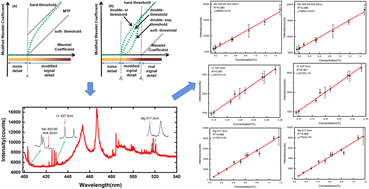Denoising preprocessing using novel wavelet threshold functions in laser-induced breakdown spectroscopy based on fiber laser†
Abstract
Fiber lasers have great advantages in long-time operations and stable power, showing great potential in laser-induced breakdown spectroscopy (LIBS) for industrial online diagnosis. However, the very high repetition frequency of fiber lasers results in much stronger noise from bremsstrahlung and multi-ablation in LIBS based on fiber lasers (FL-LIBS), which deteriorates the analytical accuracy. In order to reduce the influence of noise, the theory of entropy analysis was introduced to investigate wavelet functions with various thresholds in simulation and experiment under the FL-LIBS conditions. Two improved threshold processing methods were proposed. In the simulation, SNR#, RMSE, smoothness, peak error, and FWHM error were used to evaluate thresholds; then, five threshold functions were selected and further demonstrated in the experiment. The experimental results showed that the analytical accuracy of Mn, Cr, and Mg elements in aluminum alloys was greatly improved by preprocessing with thresholds of double-exp and MTF. It was demonstrated that preprocessing with these wavelet threshold functions can provide higher analytical accuracy in FL-LIBS.

- This article is part of the themed collection: JAAS HOT Articles 2023


 Please wait while we load your content...
Please wait while we load your content...